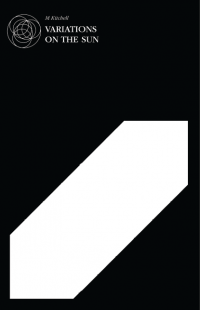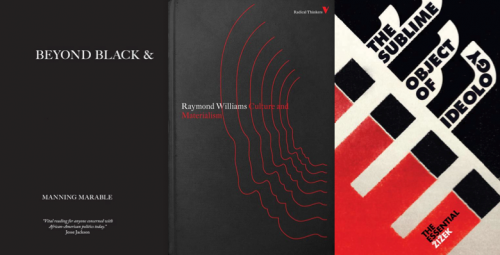 Variations on the Sun
Variations on the Sun
by M Kitchell
Love Symbol Press, 2012
88 pages / $12 (print) $1 (digital) buy from Love Symbol Press
1. I think I bought the last physical copy of this book, but you can still buy it in pdf form. Hopefully there will be another print run or something cool happens in a second edition.
2. When I opened the envelope I thought the book was damaged because it had what looked like worn out areas on all the areas that a book normally gets worn out areas. I was kind of pissed. Those are actually just part of the design. I am really excited about that now. It reminds me of Scorch Atlas, though much more subtle, crisp, and clean.
3. The cover design reminds me of these books by Verso:
4. I don’t think any description of the book I read in advance of reading the book, does the book any justice. This kind of writing:
“
i can’t help but feel totally fucking outside of myself when i try to come to terms with my position as a body a human body in the midst of whatever-the-fuck-it-is that i’m trying to do
“
– THE SALT VOICES
is next to this kind of writing:
“
There are no faces on the bodies, no arms, no legs, no genitalia, no hair, no eyes, no fingernails, no fingers, no hands, no toes, no feet, no ears, no nose, no mouth, no eyebrows, no eyelashes, no eyes, no chest, no armpits, no nipples, no bellybutton, no ass-hole, no ass, no crotch, no torso, no hips, there are no bodies.
“
– THE NEGATION OF BODIES
There are lots of other tones and styles inside the book as well. There are also photographs. Everything looks really nice.
5. This is the first book from Love Symbol Press. If they keep this up, they will be my favorite press.
6. At times Variations on the Sun reads like a textbook on architecture. There is also a lot of violence, but sometimes it’s very cute. And other times it’s very stark. At other times still, very baroque. I have a hard time finding other poetries that compare to this one.
7. Last time I talked to Evan Lavender-Smith, he used the term New Brutalism to describe the style of Blake Butler, Christopher Higgs, M Kitchell, Ken Baumann, etc. I find the term pretty accurate when compared to Brutalism, the architectural movement born out of post-WWII Europe. At first I thought he was just riffing, talking about Blake’s review of Leaving the Atocha Station, but it made sense: New Brutalism, a literature born during the Global War on Terror.
8. I don’t really know anything about architecture, outside of wikipedia and some art history classes as an undergrad, but I find the way Brutalist structures are described by Prince Charles to be pretty amusing: “You have to give this much to the Luftwaffe, at least when it knocked down our buildings they didn’t replace them with anything more offensive than rubble.”
9. Other than things online, I haven’t read anything by M Kitchell before.
10. Looking at works of New Brutalism would be a good way to enter the book, but so would the works of New Sincerity, especially the poetry of Tao Lin.
11. Yeah, I just compared the writing of M Kitchell to the poetry of Tao Lin.
12. Less than half-way through the review and I’ve brought up Tao Lin and submitted a new word to describe an entire sub-genre of literature. I think I jumped the shark.
13. While we were talking about literature, Evan also told me that the very next book I should read is Infinite Jest, so maybe he was wrong about New Brutalism being a thing. But Evan is really smart, so I trust him.
14. I feel like this line, I am fucked existentially, by Tao Lin in i am a little bit happier than you (you can read the whole poem and good thoughts on New Sincerity at Elisa Gabbert’s blog) is kinda like THE SALT VOICES, or I was reminded of that poem, when I read THE SALT VOICES.
15. There’s this cool thing in Variations on the Sun that I should say something about:
When there is a photograph on the backside of a page, it creates an off-white frame for the words on the front side of the page. I’m not sure if this was intentional, but it is a pleasing aspect of the book. I think that when there is good design in a book, even unintentional things can be really good.
16. We suggest they use the gun to build a bomb. -pg. 71.
17. There are two very important themes that I’ve forgotten to mention thus far: Arcadia and Apocalypse. Neither theme is overt, and it seems that both are parallel, or cyclical. We are constantly leaving Arcadia and constantly experiencing Apocalypse. Our Arcadia was someone elses Apocalypse. Arcadia, in Variations on the Sun, is not mourned for, but escaped from: walking through the flames held its own allure, whether we were ready to leave or not.
18. Most of the photographs are landscapes or interior still-lifes. The buildings depicted in the photographs in Variations on the Sun might be generally described as Brutalist, that is, square, concrete buildings that jut out from the surface of the earth. One of the photographs depicts an aircraft carrier.
19. I’ve said it earlier, but I feel that there are a lot of different tones and styles here. I felt a little Zachary Schomburg in this passage:
“
After we finish dinner, before we go to bed, we put on our fear masks so we can discover what the world of terror will be like. The masks become our face and we sit in upholstered chairs in a state of relaxation and calm. Our faces send signals to our brain and we forget about what we call the Real and start to know Truth.
“
-THE GLOW AND ITS EDGES
Because of the reference to Lacan’s “Real,” this passage also reminds me of Slavoj Žižek’s Welcome to the Desert of the Real, which is a book that (to put it very basically) analyzes the impact of 9/11 on culture and ideology through the lens of Marx and Lacan. We are terrified because we know how to act terrified. Though it has the playful surrealism of Schomburg, Variations of the Sun uses that playfulness to talk about psychoanalysis and critical theory.
Another interesting piece is INSTRUCTIONS FOR THE EVENT:
“
1. Remove your skin, it’s too cold, let your muscle breathe the air.
2. Walk around, leaving bloody footprints, evidence of the body.
3. Hold your breath and attempt to hold still, the shake of your muscles will
eventually stop…
“
INSTRUCTIONS FOR THE EVENT reminds me of Yoko Ono’s Grapefruit, which is a bunch of instructions for performance art pieces. Much like INSTRUCTIONS FOR THE EVENT, many of the instructions in Grapefruit are impossible to actually perform.
20. When is A.D. Jameson going to write a series of 5,000+ word blogposts about New Brutalism?
21. Doing some research and finding mention of “New Brutalism” in academic journals, mostly in regards to architecture. The only literary reference I found is an essay titled, RE/Search, J.G. Ballard New Brutalist Aftermath Aesthetics. It’s an interesting and relevant essay:
“
At various points throughout (The Atrocity Exhibition), the geometry of the human body is rendered topologically analogous to the landscape, to architecture, to maps, to concrete and, as is suggested by Gloeckner’s illustration, to road networks, too.
“
-Joanne Murray, European Journal of American Culture, Vol. 30, No. 2. 2011.
(if anyone’s interested, I’ll email you a .pdf of this essay)
22. It’s really hard to describe exactly what the book is. It’s not New Sincerity or New Brutalist. It’s not like reading Blake Butler or like reading Tao Lin. Variations on the Sun is very much its own thing. It’s truly cross genre. It’s fiction, poetry, philosophy, cultural studies, critical theory, all intersecting in a physical book.
23. Variations on the Sun’s narrative (though very loose, a narrative does exist) leaves and grows and ages and resists aging and resists leaving, though all these things are inevitable.
24. Sometimes I forgot that there were titles for each piece. The titles are really good and do a great job of actually interacting with the piece. I also forgot that all the pieces are numbered as well.
25. People should really consider paying a dollar to have the chance to read this book. It’s a great read. If you own a physical copy, you should think about loaning it to people who like well designed books and are good at returning books.
Robert Alan Wendeborn is a composition instructor at San Juan College during the school year, and teaches book arts to preteens at Oregon College of Art and Craft during the summer. His poems have appeared in Pank, >killauthor, Sink Review, and Elimae.
Tags: 25 Points, Love Symbol Press, m kitchell, Variations on the Sun


Enjoyed reading his, Robert. And I really like the potential of theorizing “New Brutalism.” (Maybe I’ll beat Jameson to the 5,000 word punch!) If you can get your hands on it, the scholarly journal OCTOBER did a special issue on New Brutalist architecture back in spring of last year. Hal Foster’s essay sticks in my head as a good one in that bunch.
Remember that time you came to my house and ELS & Richard Greenfield almost got into a fistfight over a poem? Yeah, that was fun.
Richard was so right too, but when he gets mad, he doesn’t know how to use his words.
Thanks for paying attention to the material qualities of the book–a lot of what you’ve noted are, for me, quintessential parts of the reading experience. This, on the one hand, makes me partially averse to the fact that an eBook exists, but I of course still want it to be available & read despite being out of print, although I think the experience of the print object is entirely different!
Yeah, the physical object of a book is really important to me. Some books don’t rely on form at all. To me, if your book is meant to be innovative it should be very conscience of its form, even if it is an ebook. A physical book that is unaware of its physicality, just words on a page, is the same as words on a screen. But a physical book that is designed to be handled, gazed upon, and read has the ability to merge the visual and literary arts.
Earlier in the day I was talking with Russ and a person who also had purchased the book online. Apparently the distressed features of the book were from the particular envelopes used to ship the book. I like that it’s enjoyable through it’s deterioration.